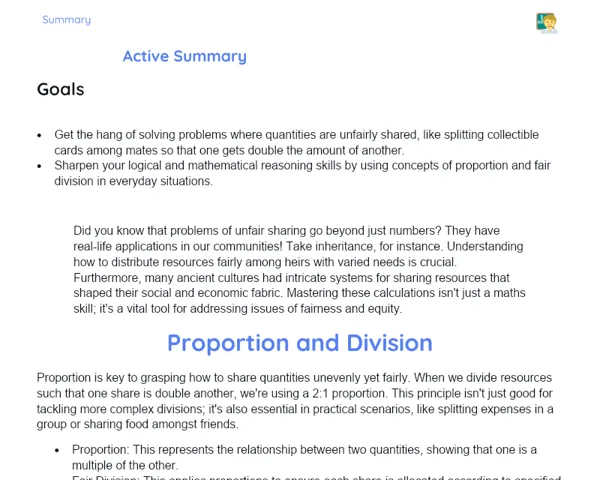Summary Tradisional | Triangles: Classification by Sides
Contextualization
Triangles are basic geometric shapes with three sides and three vertices, made up of three line segments. They are significant not just in mathematics but also in various practical fields like engineering and architecture. Understanding and classifying triangles is vital for tackling more complex problems and applying them in real-world scenarios.
When we classify triangles according to their sides, we look at whether they are equilateral, isosceles, or scalene. An equilateral triangle has all sides the same length; an isosceles triangle has two sides that are equal and one that is different; while a scalene triangle has all sides of different lengths. Additionally, to form a triangle, the sum of the lengths of any two sides has to be greater than the length of the third side. This concept is crucial for ensuring the stability and strength of structures in the building industry and other practical uses.
To Remember!
Classification of Triangles by Sides
Triangles can be sorted into three main kinds based on the lengths of their sides: equilateral, isosceles, and scalene. This classification is important for grasping the geometric properties of triangles and their practical implications. Knowing the distinctions among these types aids in solving geometric problems with greater accuracy and applying these ideas in various sectors such as construction and design.
An equilateral triangle features all three sides equal, which also means all its internal angles are equal, each measuring 60 degrees. This symmetry lends equilateral triangles a distinct stability, making them popular in designs that need uniformity and balance.
An isosceles triangle boasts two equal sides and one different side. The angles opposite the equal sides are likewise equal, providing a certain symmetry to the figure. This characteristic makes isosceles triangles common in practical applications like the roofs of houses and other architectural constructs.
A scalene triangle has sides of all different lengths, resulting in all internal angles being different as well. This type of triangle is the most general and can be observed in various irregular shapes found in nature and human design, allowing for adaptability in practical applications.
-
Equilateral triangle: all sides equal and internal angles equal to 60 degrees.
-
Isosceles triangle: two sides equal and one different, with angles opposite the equal sides also equal.
-
Scalene triangle: all sides and internal angles different.
Equilateral Triangle
An equilateral triangle is a triangle where all three sides are equal. Additionally, the internal angles of an equilateral triangle are always equal, each measuring 60 degrees. This symmetry makes the equilateral triangle a unique figure in terms of balance and structural stability.
In practice, equilateral triangles are frequently used in scenarios that require uniformity and balanced force distribution. For instance, in civil engineering, equilateral triangular structures are employed to ensure the stability of bridges and buildings. The uniformity of angles and sides allows force to be evenly spread throughout the structure.
Moreover, equilateral triangles are popular in design and art because of their symmetrical appearance. The regularity of this shape creates a sense of visual harmony, making it a sought-after element in decorative patterns and artistic compositions.
-
All sides are equal.
-
All internal angles measure 60 degrees.
-
Used in civil engineering to ensure stability.
-
Popular in design and art due to its symmetrical aesthetic.
Isosceles Triangle
The isosceles triangle is defined by having two sides of equal length and one different side. The angles opposite the equal sides are also equal, contributing to the figure's partial symmetry. This property makes isosceles triangles very useful in practical applications.
In architecture, isosceles triangles are often employed in roofs and other structures that need a stable base with a central point of elevation. The symmetry of the angles and sides allows for a balanced distribution of loads, enhancing the stability of the construction.
Additionally, the property of equal angles in isosceles triangles can simplify solving geometric problems. Identifying isosceles triangles in complex figures often makes it easier to determine unknown angles and sides.
-
Two sides equal and one different.
-
Angles opposite the equal sides are also equal.
-
Used in roofs and other architectural structures.
-
Helps simplify complex geometric problems.
Scalene Triangle
A scalene triangle is a triangle where all three sides have different lengths. As a result, all internal angles are different as well. This asymmetry makes the scalene triangle a highly adaptable geometric shape used in various practical situations.
In engineering, scalene triangles are often seen in structures that require irregular shapes, such as certain types of bridges or mechanical components. The variety of angles and sides offers design flexibility that can cater to specific requirements.
Furthermore, understanding scalene triangles is key for solving more complex geometric problems. Being able to identify and classify scalene triangles in intricate figures aids in determining unknown measurements and provides a clearer insight into the structure of the figure overall.
-
All sides have different lengths.
-
All internal angles are different.
-
Used in structures requiring irregular shapes.
-
Essential for solving complex geometric problems.
Conditions for the Existence of a Triangle
For three line segments to come together as a triangle, it is critical that the sum of the lengths of any two sides is always greater than the length of the third side. This rule is known as the triangle inequality and is fundamental for establishing whether a triangle can exist.
For example, take three segments with lengths of 3 cm, 4 cm, and 5 cm. To check if these can form a triangle, we must confirm the following: 3 + 4 > 5, 3 + 5 > 4, and 4 + 5 > 3. Since all these inequalities hold true, these segments can indeed form a triangle.
On the other hand, if we consider segments of 1 cm, 2 cm, and 4 cm, 1 + 2 is not greater than 4, indicating these segments cannot form a triangle. This verification process is crucial in various practical applications, such as engineering and architectural projects, to ensure shapes and structures are feasible and stable.
-
The sum of any two sides must be greater than the third side.
-
Fundamental for confirming the existence of a triangle.
-
Vital in engineering and architectural projects.
-
Aids in assessing the viability and stability of structures.
Key Terms
-
Equilateral Triangle: Triangle with all sides and angles equal.
-
Isosceles Triangle: Triangle with two equal sides and one different, with angles opposite the equal sides also equal.
-
Scalene Triangle: Triangle with all sides and internal angles different.
-
Condition for the Existence of a Triangle: The sum of the lengths of any two sides must be greater than the length of the third side.
Important Conclusions
In today's lesson, we delved into the classification of triangles based on their sides, identifying the equilateral, isosceles, and scalene varieties. We learned that an equilateral triangle has all equal sides, an isosceles triangle has two sides that are equal and one that is different, while a scalene triangle features all sides of different lengths. We also touched on the importance of the conditions necessary for a triangle to exist, affirming that the sum of any two sides must be greater than the length of the third side.
These concepts are not only instrumental for solving geometric problems but are also applicable in various fields like engineering and architecture. The structural stability that triangles provide is crucial for building safe and durable structures. Thus, the knowledge gained in this lesson is highly pertinent to a range of disciplines and real-world situations.
We encourage students to keep exploring this topic, as a solid understanding of triangles and their geometric properties can pave the way to various academic and career opportunities. Regular practice and the application of these concepts in diverse contexts will reinforce their knowledge and foster a strong grasp of geometry.
Study Tips
-
Review the various classifications of triangles by side length and try to find examples in everyday life.
-
Practice solving geometric problems involving triangles, making sure to check the conditions for their existence and classify them accordingly.
-
Investigate practical applications of triangles in engineering and architecture, examining how their properties contribute to structural stability.



